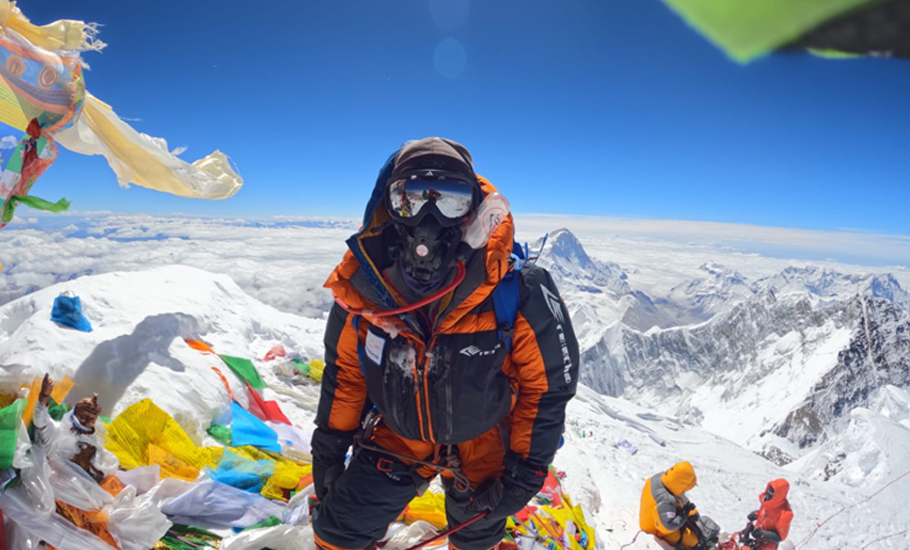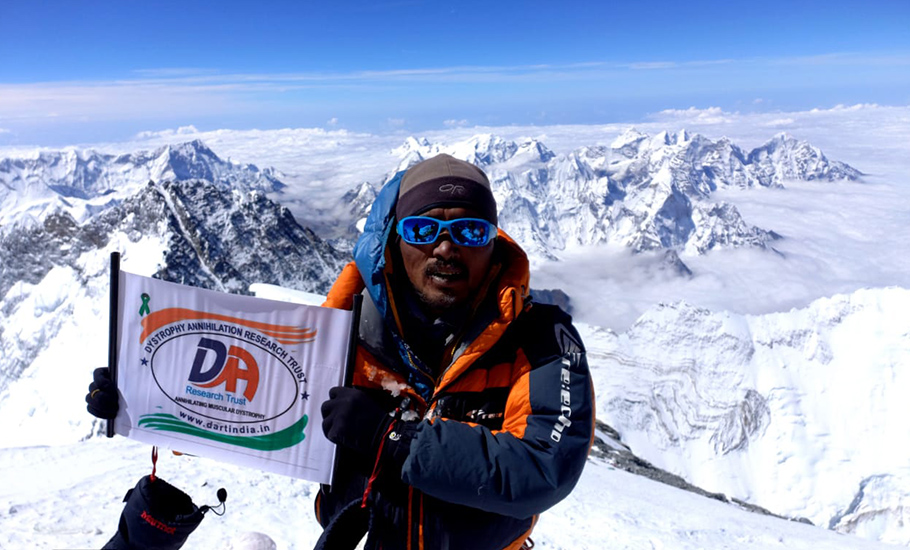
- Home
- News
- Analysis
- States
- Perspective
- Videos
- Education
- Entertainment
- Elections
- World Cup 2023
- Features
- Health
- Business
- Series
- Economy Series
- Earth Day
- Kashmir’s Frozen Turbulence
- India@75
- The legend of Ramjanmabhoomi
- Liberalisation@30
- How to tame a dragon
- Celebrating biodiversity
- Farm Matters
- 50 days of solitude
- Bringing Migrants Home
- Budget 2020
- Jharkhand Votes
- The Federal Investigates
- The Federal Impact
- Vanishing Sand
- Gandhi @ 150
- Andhra Today
- Field report
- Operation Gulmarg
- Pandemic @1 Mn in India
- The Federal Year-End
- The Zero Year
- Premium
- Science
- Brand studio
- Home
- NewsNews
- Analysis
- StatesStates
- PerspectivePerspective
- VideosVideos
- Entertainment
- ElectionsElections
- Sports
- Loading...
Sports - Features
- BusinessBusiness
- Premium
- Loading...
Premium

'This one was special': What pushed a 5-time Everest climber to risk it one more time

If you got a message, shout it from the mountain tops. If you got an important message, shout it out from the highest mountain there is. Two mountaineers did exactly that recently. Their message: muscular dystrophy is a huge problem in India and needs greater attention from the government, the people and the medical fraternity. The idea to spread the message by scaling the peak over 8,848.86...
If you got a message, shout it from the mountain tops. If you got an important message, shout it out from the highest mountain there is. Two mountaineers did exactly that recently. Their message: muscular dystrophy is a huge problem in India and needs greater attention from the government, the people and the medical fraternity.
The idea to spread the message by scaling the peak over 8,848.86 m (29,031.7 ft), from Earth’s centre struck the duo five years ago when Sonam Sherpa happened to meet Mithun during a trek to Kala Patthar. As an icefall doctor, Sonam has seen people from many walks of life. Mithun, however, was a man on a mission. His trek was no adventure trip but part of a greater and nobler plan.
Mithun’s son was undergoing treatment for muscular dystrophy. Even though India has one of the highest cases of muscular dystrophy, lack of awareness among people prevents many from getting proper care. To tide over the problem of information gaps, general apathy borne out of a lack of understanding and dearth of proper care, Mithun wanted to raise the issue in a big way and so he asked Sonam if he would help him in the cause. Sonam readily agreed. But the plan would remain a plan for the next five years.
The duo decided they needed to raise awareness right from the Everest peak, but didn’t know how to get it up there. They spoke to people and reached to various organisations for help over two years. But their efforts had to be halted when the pandemic struck. The two could not give shape to their plans as Covid cases mounted and governments imposed lockdowns and travel restrictions to stop the virus from spreading.
But as Covid cases receded and became less lethal, there was light at the end of the tunnel for Mithun and Sonam.

As people started scaling the Everest again, Sonam reached out to his friend and five-time Everest summiter Rinjen Sherpa for help. Rinjen promptly agreed.
In May, Rinjen took the flag of the Dystrophy Annihilation Research Trust (DART), a Bengaluru-based organisation where Mithun’s son is undergoing treatment, to the summit. Though Rinjen was not new to the Everest, carrying the flag for creating awareness about muscular dystrophy was new.
It took Rinjen a week to reach the summit from the base camp. The ascent was no easy task. There was an oxygen failure that threatened not just the mission but Rinjen’s own life. This was followed by heavy snowing.
At last, Rinjen could overcome all hurdles and hoist the DART flag on the summit. “Every trek to the summit is challenging. We are not new to extreme weather conditions. This one was special because we wanted to create awareness among people about muscular dystrophy. We are happy that we could hoist the flag of DART on the summit,” Rinjen tells The Federal.
Sonam nods in agreement as he discloses his reason to agree to be a part of Mithun’s case. “I come from Phakding, a tiny village in the Khumbu region of Nepal. It is a halting point for trekkers on their way to Mount Everest. I never heard of a disease called muscular dystrophy until I met Mithun’s father five years ago. I recently heard that many children in Nepal suffer from muscular dystrophy. I joined this initiative to create awareness among people who live in tiny villages like Phakding about the disease,” he says.
It was on May 11 that Rinjen and Sonam both started from the base camp by crossing the Khumbu icefall route. They reached Camp 1 and stayed there for the day. On May 12, they reached Camp 2 and on May 13, they managed to make it to Camp 3. The duo could do it so fast because the weather was good. But when they were getting ready to start from Camp 3, it started to snow heavily. Strong winds blew in a stumbling block into their plan.
“There was strong wind from the south from midnight onwards and we could not proceed much further. So, we stayed at the South Pole for a day,” Rinjen shares.
Even though the situation was bad, it improved quickly. On May 15, we could proceed to the summit. “But there were issues with oxygen. We somehow managed it. Our idea was to plant the flag on the summit. So, we were hopeful that we could do it,” he said. “A man from Australia who joined me at the South Pole was curious. He had been part of many expeditions but never experienced one like this,” he adds.
The first thing Rinjen did on scaling the peak was to hoist the DART flag. “It was a great feeling to place the flag on the summit. We took some photographs and waited for a while. The weather was nice and it allowed us to spend more time out there,” says Rinjen.
Muscular dystrophy is a group of genetic diseases characterised by progressive weakness and degeneration of skeletal and voluntary muscles which control movement. It affects cardiac and respiratory functions and other vital organs as well. “Muscular dystrophy is caused due to lack of a protein called dystrophin. This occurs when there are changes in the reading frame of amino acids, thereby resulting in truncated proteins, leading to less than required levels of dystrophin. It is estimated that at least 3-4 lakh people suffer from various kinds of muscular dystrophies in India,” says Dr Arun Shastry, chief scientific officer of DART.
“With a life expectancy of 20-25 years, the children currently have no complete treatment option. In many families, there is not even support for disease management. We need to address these issues immediately,” he adds.
DART was established in 2012 to provide support to the families of children with muscular dystrophy.
The organisation was established by RS Anand after he found that his son was suffering from Duchenne muscular dystrophy in 2003. The idea was to bring together all muscular dystrophy patients and their parents to create awareness about treatment, drug trials and facilitating research in finding solutions to eradicate the disease. In 2018, DART became the first institution in the world to carry out and show successful results in the single-patient clinical research study on multiple exon skipping. “Besides creating awareness, the idea behind hoisting the DART flag on the summit of Mount Everest was to announce to the world that we have reached the stage of starting clinical trials after completing research and development on our novel drug to treat DMD,” Shatry says.
The successful completion of the mission has made both Sonam and Rinjen happy.
“The expedition which involved carrying the flag to create awareness was special. The main reason was that it redefined our trek to the summit. It became a meaningful one. We sent the images with the flag of DART on the summit to our friends and relatives. Many didn’t understand so we had to explain to them what MD meant. We are happy that we could do at least this for our people,” says Sonam.

